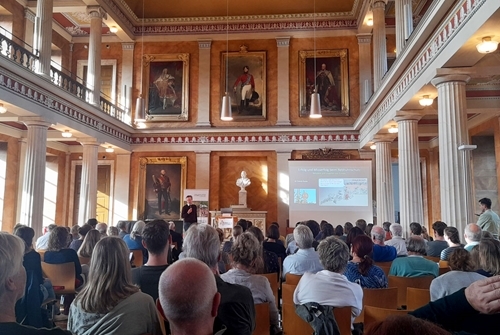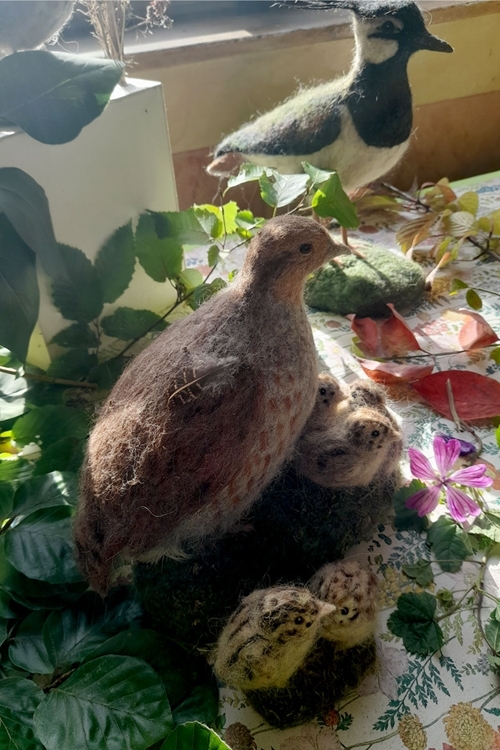By Jasmine Canham, Wildlife Recovery placement student
What do Pierce Brosnan and the grey partridge have in common? More than you would think!
The beloved British spy 007, played by Brosnan from 1995-2002, was in fact named after a real man called James Bond – a prolific American ornithologist of the 20th Century. In the 2002 film Die Another Day, you can see several hints to ornithology and the character’s namesake, including a book, Birds of the West Indies, that the real Bond genuinely wrote.
Why is this relevant? Well, at the beginning of October I attended a conference in Göttingen, Germany with my supervisor, Dr Francis Buner, who was invited to give a talk there. It was with this interesting fact that the President of Göttingen University, Professor Metin Tolan, opened the day. The conference centred around a new national grey partridge project in Germany: ‘Rebhuhn retten – Vielfalt fördern!’ or, in English, ‘Save the grey partridge – promote biodiversity!’
 Dr Francis Buner from the GWCT delivering his keynote presentation.
Dr Francis Buner from the GWCT delivering his keynote presentation.
Following on from the seven-year Interreg NSR PARTRIDGE project, led by the GWCT, of which Germany was a partner country, this new project has established ten project sites across Germany to help save the partridge and benefit farmland biodiversity. It aims to make 7% of the project areas partridge-friendly by 2029 through implementing habitat measures, advising farmers, and species monitoring.
Once one of the most common farmland birds in Europe, the grey partridge (Perdix perdix) has declined by 94% since 1980 across the continent. In the UK it is a red-listed bird and has experienced a population decline of 92% from 1967-2020, one of the steepest declines of any bird species in the country and not far behind the iconic turtle dove (Streptopelia turtur). In Germany, only 50,000 partridges remain. To put this into context, as Prof. Metin Tolan explained, this is about the same number as staff and students combined at Göttingen University where the conference was held.
Not only is this population decline distressing on its own, the grey partridge is also an important flagship species for wider conservation and helps us understand the environment around us. Widely regarded as a ‘barometer’ of the countryside, if the partridge is struggling, other species are likely to be too.
 Sadly we couldn’t invite any real partridges, however we did get
Sadly we couldn’t invite any real partridges, however we did get
to admire these beautiful felted pieces made by Vera Grenner.
After starting the day with a delicious buffet (a good crowd pleaser) and being welcomed by the President of the university, we enjoyed a series of talks covering a range of topics such as an overview of the six-year project, species monitoring, the Common Agricultural Policy (CAP) and the best methods for conserving grey partridge. The coffee breaks between talks also provided an interesting opportunity to chat to other attendees and learn about their work. Highlights of the day included, of course, a headline talk from Dr Francis Buner entitled ‘Grey partridge conservation successes and failures from across Europe – how to learn from other people’s mistakes’, and the presentation of a large symbolic cheque worth €10 million by a representative of the German Federal Ministry for the Environment, Nature Conservation, Nuclear Safety and Consumer Protection (BMUV), which marked a particularly exciting moment for the German project team.
It is hard to believe that a species that was once so widespread now requires such a large effort to bring it back from the brink. This project, significant enough for €10 million of funding, will help combat this species’ decline in Germany, and with it help farmland diversity to thrive. Despite the harrowing statistics, this was a very informative and, in many ways, uplifting trip. This conference demonstrated that when like-minded wildlife biologists band together, large-scale, country-wide recovery projects are achievable.
It was certainly very impressive to hear the German BMUV Minister declare in a recent interview that the grey partridge was an important species to save, especially as it holds the status of an umbrella species: if the the grey partridge is saved, farmland biodiversity can be saved at the same time. If Germany can do it, we in the UK certainly can, or can we not? I, for my part, certainly think so and look forward to hopefully seeing something similar in the UK soon.